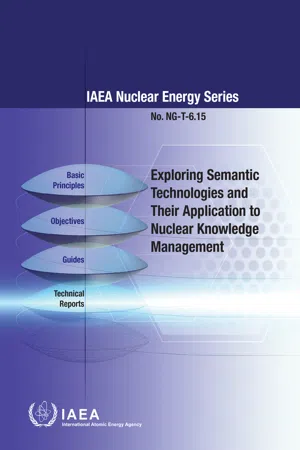1. Introduction
1.1. Background
Within the past decade, the capability of machines to present, share and act upon knowledge has dramatically increased. This has become evident in the rapid growth of knowledge repositories such as Wikipedia and the omnipresence of search engines, which nowadays present a wealth of information related to the user’s query, far exceeding their original goal of merely searching documents on the World Wide Web. The technologies that have enabled this development are customarily defined as ‘semantic technologies’. From a knowledge management perspective, it is worthwhile to investigate these capabilities, which are most conspicuous in the public domain — within the more constrained scope of organizations — and to relate them to the specific tasks encountered in managing nuclear knowledge.
In particular, semantic technologies provide the ability to connect and relate content deriving from many different sources. Traditionally, most repositories of knowledge and information have been developed as stand-alone systems or systems with limited connectivity, often confined within the boundaries of a single organization. However, such information silos have prevented the gathering and relating of information needed for resolving the problem at hand from different, usually distributed and heterogeneous sources.
The ability to interlink data lies at the core of the enhanced capabilities of search engines not only to retrieve documents containing the requested keywords, but also to offer additional information relevant to the topic. This is achieved by querying an underlying knowledge base, which is constructed (off-line and/or on the fly) using knowledge organization systems from different provenances available on the World Wide Web, and linking them to form extensive knowledge structures, which can be further navigated by the user and used in the development of a variety of knowledge based services and applications.
Exploiting the capabilities of semantic technologies is of particular relevance in the nuclear field, which is fundamentally knowledge driven, and which strongly depends on sharing nuclear knowledge in and between all phases of designing, constructing, operating and decommissioning nuclear facilities. Although the introduction of new information technologies in nuclear organizations has to consider several issues, spelled out in more detail in Section 4, many nuclear organizations have realized the significant benefits that semantic technologies can provide, and accordingly have started programmes in various areas of interest.
1.2. Objective
The rapid development of knowledge bases and knowledge based applications is changing the way that knowledge is managed profoundly. As machines increasingly ‘understand’ the meaning of the concepts involved by evaluating the attributes characterizing them and the relationships between them, developing knowledge bases by deploying semantic technologies becomes an important issue in managing knowledge. This publication provides insight into the fundamentals of semantic technologies and the tools and methods used to develop knowledge bases.
Within the nuclear field, the vast body of knowledge, involving many scientific, technical and managerial fields, is distributed among many organizations of different types. Managing and provisioning distributed knowledge is therefore becoming one of the major challenges in federated organizational environments. This is certainly a relevant issue for the IAEA, whose mostly knowledge based activities have to be coordinated among 172 Member States (as of September 2020), more than 2500 employees and several special interest groups and stakeholders who produce and consume millions of database records, web sites and other sources of information.
In addition to providing insight into the development of distributed knowledge bases, this publication provides examples of applications of semantic technologies specifically in the nuclear field.
1.3. Scope
This publication gives an insight into semantic technologies, their use in building knowledge bases and the development of knowledge driven services and applications. As knowledge in the nuclear field is hosted in many different organizations around the world, a dominant concern is the management of distributed knowledge.
This publication is applicable to all organizations concerned with managing knowledge for knowledge sharing, preservation and use, thereby covering the whole life cycle of knowledge. As knowledge bases are increasingly used as foundations for applications and services, the development of such applications is described, and examples are given that assist knowledge management and informatics units in the design of such systems.
1.4. Structure
This publication is structured as follows:
Section 2 introduces the impact of semantic technologies on knowledge management and states the problem of managing knowledge under the conditions of distributed knowledge, pointing out the challenges encountered in an organization, and introducing semantic technologies and the standardization efforts by the World Wide Web Consortium (W3C).
Section 3 gives a general overview of knowledge organization. It discusses current trends in knowledge organization, provides a classification scheme that enables the scale and scope of various knowledge organization systems to be defined in relation to each other, and discusses the topic of interoperability as an important design principle in the organization of distributed knowledge. It further discusses Semantic Web technologies, a set of standards defined by the W3C to improve...
